The Impacts of Phenological Stages within the Annual Cycle on Mapping Forest Stock Volume Using Multi-Band Dual-Polarization SAR Images in Boreal Forests
Abstract
:1. Introduction
2. Study Area and Data
2.1. Study Area
2.2. Ground Data
2.3. Dual-Polarization SAR Images
2.4. Digital Elevation Model
3. Methods
3.1. SAR Images Preprocessing
3.2. Extracting Variables from SAR Images
3.2.1. Backscattering Coefficients and Derived Variables
3.2.2. Decomposition Variables and RVI
3.2.3. Texture Variables
3.3. Variable Evaluation and Models
3.4. Accuracy Evaluation Indices
4. Results
4.1. The Results of Backscattering Coefficients Related to Forest Phenological Factors
4.2. The Sensitivity Results of Variables Related to Forest Growth and Dormant Stages
4.3. The Results of Mapped FSV Using Single-Band SAR Images
4.3.1. The Results of Estimated FSV Using Single Data during the Dormant Stage
4.3.2. The Results of Estimated FSV Using Single Data during the Growth Stage
4.4. The Results of Mapped FSV by Multi-Band SAR Images
4.4.1. The Mapped FSV Using Multi-Band SAR Images during the Dormant Stage
4.4.2. The Mapped FSV Using Multi-Band Images Acquired in the Growth Stage
5. Discussion
5.1. Analyzing the Correlations between Variables and FSV between the Growth and Dormant Stages
5.2. The Contributions of Multi-Bands Combination
6. Conclusions
Author Contributions
Funding
Data Availability Statement
Conflicts of Interest
References
- Jiang, F.; Kutia, M.; Sarkissian, A.J.; Lin, H.; Long, J.; Sun, H.; Wang, G. Estimating the growing stem volume of coniferous plantations based on random forest using an optimized variable selection method. Sensors 2020, 20, 7248. [Google Scholar] [CrossRef] [PubMed]
- Shi, L.; Liu, S. Methods of estimating forest biomass: A review. Biomass Vol. Estim. Valorization Energy 2017, 10, 65733. [Google Scholar] [CrossRef]
- White, J.C.; Coops, N.C.; Wulder, M.A.; Vastaranta, M.; Hilker, T.; Tompalski, P. Remote sensing technologies for enhancing forest inventories: A review. Can. J. Remote Sens. 2016, 42, 619–641. [Google Scholar] [CrossRef]
- Franceschetti, G.; Lanari, R. Synthetic Aperture Radar Processing; CRC Press: Boca Raton, FL, USA, 2018. [Google Scholar] [CrossRef]
- Nuthammachot, N.; Askar, A.; Stratoulias, D.; Wicaksono, P. Combined use of Sentinel-1 and Sentinel-2 data for improving above-ground biomass estimation. Geocarto Int. 2022, 37, 366–376. [Google Scholar] [CrossRef]
- Patenaude, G.; Milne, R.; Dawson, T.P. Synthesis of remote sensing approaches for forest carbon estimation: Reporting to the Kyoto Protocol. Environ. Sci. Policy 2005, 8, 161–178. [Google Scholar] [CrossRef]
- Shao, Z.; Zhang, L. Estimating Forest aboveground biomass by combining optical and SAR data: A case study in Genhe, Inner Mongolia, China. Sensors 2016, 16, 834. [Google Scholar] [CrossRef]
- Thies, B.; Bendix, J. Satellite based remote sensing of weather and climate: Recent achievements and future perspectives. Meteorol. Appl. 2011, 18, 262–295. [Google Scholar] [CrossRef]
- Xu, Q.; Dong, X.; Li, W. Integrated space-air-ground early detection, monitoring and warning system for potential catastrophic geohazards. Geomat. Inf. Sci. Wuhan Univ. 2019, 44, 957–966. [Google Scholar] [CrossRef]
- Berninger, A.; Lohberger, S.; Zhang, D.; Siegert, F. Canopy height and above-ground biomass retrieval in tropical forests using multi-pass X-and C-band Pol-InSAR data. Remote Sens. 2019, 11, 2105. [Google Scholar] [CrossRef]
- Kurum, M.; Kim, S.B.; Akbar, R.; Cosh, M.H. Surface Soil Moisture Retrievals Under Forest Canopy for L-Band SAR Observations Across a Wide Range of Incidence Angles by Inverting a Physical Scattering Model. IEEE J. Sel. Top. Appl. Earth Obs. Remote Sens. 2020, 14, 1741–1753. [Google Scholar] [CrossRef]
- Santoro, M.; Cartus, O.; Fransson, J.E.S.; Wegmüller, U. Complementarity of X-, C-, and L-band SAR backscatter observations to retrieve forest stem volume in boreal forest. Remote Sens. 2019, 11, 1563. [Google Scholar] [CrossRef]
- Antropov, O.; Rauste, Y.; Häme, T.; Praks, J. Polarimetric ALOS PALSAR time series in mapping biomass of boreal forests. Remote Sens. 2017, 9, 999. [Google Scholar] [CrossRef]
- Huang, X.; Ziniti, B.; Torbick, N.; Ducey, M.J. Assessment of forest above ground biomass estimation using multi-temporal C-band Sentinel-1 and Polarimetric L-band PALSAR-2 data. Remote Sens. 2018, 10, 1424. [Google Scholar] [CrossRef]
- Shi, J.; Zhang, W.; Marino, A.; Zeng, P.; Ji, Y.; Zhao, H.; Huang, G.; Wang, M. Forest total and component biomass retrieval via GA-SVR algorithm and quad-polarimetric SAR data. Int. J. Appl. Earth Obs. Geoinf. 2023, 118, 103275. [Google Scholar] [CrossRef]
- Ji, K.; Wu, Y. Scattering Mechanism Extraction by a Modified Cloude-Pottier Decomposition for Dual Polarization SAR. Remote Sens. 2015, 7, 7447–7470. [Google Scholar] [CrossRef]
- Van Zyl, J.J.; Arii, M.; Kim, Y. Requirements for model-based polarimetric decompositions. In Proceedings of the 7th European Conference on Synthetic Aperture Radar, Friedrichshafen, Germany, 2–5 June 2008; pp. 1–4. [Google Scholar]
- Freeman, A.; Durden, S.L. A three-component scattering model for polarimetric SAR data. IEEE Trans. Geosci. Remote Sens. 1998, 36, 963–973. [Google Scholar] [CrossRef]
- Dobson, M.C.; Ulaby, F.T.; Pierce, L.E.; Sharik, T.L.; Bergen, K.M.; Kellndorfer, J.; Kendra, J.R.; Li, E.; Lin, Y.C.; Nashashibi, A.; et al. Estimation of forest biophysical characteristics in Northern Michigan with SIR-C/X-SAR. IEEE Trans. Geosci. Remote Sens. 1995, 33, 877–895. [Google Scholar] [CrossRef]
- Ranson, K.J.; Sun, G. Effects of environmental conditions on boreal forest classification and biomass estimates with SAR. IEEE Trans. Geosci. Remote Sens. 2000, 38, 1242–1252. [Google Scholar] [CrossRef]
- Luo, Y.; Liu, Y.; Huang, H.; Yu, L.; Ren, L. Pathway and method of forest health assessment using remote sensing technology. J. Beijing For. Univ. 2021, 43, 1–13. [Google Scholar] [CrossRef]
- Bjerreskov, K.S.; Nord-Larsen, T.; Fensholt, R. Classification of nemoral forests with fusion of multi-temporal sentinel-1 and 2 data. Remote Sens. 2021, 13, 950. [Google Scholar] [CrossRef]
- Fang, G.; Yu, H.; Fang, L.; Zheng, X. Synergistic Use of Sentinel-1 and Sentinel-2 Based on Different Preprocessing for Predicting Forest Aboveground Biomass. Forests 2023, 14, 1615. [Google Scholar] [CrossRef]
- Yang, Y.; Yang, G.; Zhao, H. Estimation of Forest Volume in Karst Mountain Ecosystem with Synthetic Aperture Radar Remote Sensing technology. For. Resour. Manag. 2018, 4, 100. [Google Scholar] [CrossRef]
- Yu, Y.; Saatchi, S. Sensitivity of L-band SAR backscatter to aboveground biomass of global forests. Remote Sens. 2016, 8, 522. [Google Scholar] [CrossRef]
- Ackermann, N. Growing Stock Volume Estimation in Temperate Forested Areas Using a Fusion Approach with SAR Satellites Imagery; Springer: Berlin/Heidelberg, Germany, 2014. [Google Scholar] [CrossRef]
- Cooke, J.E.K.; Eriksson, M.E.; Junttila, O. The dynamic nature of bud dormancy in trees: Environmental control and molecular mechanisms. Plant Cell Environ. 2012, 35, 1707–1728. [Google Scholar] [CrossRef] [PubMed]
- Janssen, T.; Van Der Velde, Y.; Hofhansl, F.; Luyssaert, S.; Naudts, K.; Driessen, B.; Fleischer, K. Drought effects on leaf fall, leaf flushing and stem growth in the Amazon forest: Reconciling remote sensing data and field observations. Biogeosciences 2021, 18, 4445–4472. [Google Scholar] [CrossRef]
- Koyama, C.N.; Watanabe, M.; Hayashi, M.; Ogawa, T.; Shimada, M. Mapping the spatial-temporal variability of tropical forests by ALOS-2 L-band SAR big data analysis. Remote Sens. Environ. 2019, 233, 111372. [Google Scholar] [CrossRef]
- Li, D.; Wang, C.; Hu, Y.; Liu, S. General review on remote sensing-based biomass estimation. Geomat. Inf. Sci. Wuhan Univ. 2012, 37, 631–635. [Google Scholar] [CrossRef]
- Hao, M.; Feng, J.M.; Feng, Z.; Jiang, G.; Sang, A.; Wu, S.; Hua, W.; Wang, Y. Variation characteristics and relationship analysis of ground temperature and precipitation in Chifeng City, Inner Mongolia from 1961 to 2020. J. Inn. Mong. Univ. (Nat. Sci. Ed.) 2022, 53, 194–202. [Google Scholar] [CrossRef]
- Zhang, T.; Lin, H.; Long, J.; Zhang, M.; Liu, Z. Analyzing the saturation of growing stem volume based on ZY-3 stereo and multispectral images in planted coniferous forest. IEEE J. Sel. Top. Appl. Earth Obs. Remote Sens. 2021, 15, 50–61. [Google Scholar] [CrossRef]
- Xu, X.; Lin, H.; Liu, Z.; Ye, Z.; Li, X.; Long, J. A combined strategy of improved variable selection and ensemble algorithm to map the growing stem volume of planted coniferous forest. Remote Sens. 2021, 13, 4631. [Google Scholar] [CrossRef]
- Ye, Z.; Long, J.; Zheng, H.; Liu, Z.; Zhang, T.; Wang, Q. Mapping Growing Stem Volume Using Dual polarization GaoFen-3 SAR Images in Evergreen Coniferous Forests. Remote Sens. 2023, 15, 2253. [Google Scholar] [CrossRef]
- Dai, X.; Chen, S.; Jia, K.; Jiang, H.; Sun, Y.; Li, D.; Zheng, Q.; Huang, J. A decision-tree approach to identifying paddy rice lodging with multiple pieces of polarization information derived from Sentinel-1. Remote Sens. 2022, 15, 240. [Google Scholar] [CrossRef]
- Shashikant, V.; Mohamed Shariff, A.R.; Wayayok, A.; Kamal, M.R.; Lee, Y.P.; Takeuchi, W. Comparison of field and SAR-derived descriptors in the retrieval of soil moisture from oil palm crops using PALSAR-2. Remote Sens. 2021, 13, 4729. [Google Scholar] [CrossRef]
- Periasamy, S. Significance of dual polarimetric synthetic aperture radar in biomass retrieval: An attempt on Sentinel-1. Remote Sens. Environ. 2018, 217, 537–549. [Google Scholar] [CrossRef]
- Liao, Z.; He, B.; Quan, X. Potential of texture from SAR tomographic images for forest aboveground biomass estimation. Int. J. Appl. Earth Obs. Geoinf. 2020, 88, 102049. [Google Scholar] [CrossRef]
- Cartus, O.; Santoro, M. Exploring combinations of multi-temporal and multi-frequency radar backscatter observations to estimate above-ground biomass of tropical forest. Remote Sens. Environ. 2019, 232, 111313. [Google Scholar] [CrossRef]
- Chen, L.; Wang, Y.; Ren, C.; Zhang, B.; Wang, Z. Assessment of multi-wavelength SAR and multispectral instrument data for forest aboveground biomass mapping using random forest kriging. For. Ecol. Manag. 2019, 447, 12–25. [Google Scholar] [CrossRef]
- Sinha, S.; Jeganathan, C.; Sharma, L.K.; Nathawat, M.S. A review of radar remote sensing for biomass estimation. Int. J. Environ. Sci. Technol. 2015, 12, 1779–1792. [Google Scholar] [CrossRef]
- Sinha, S.; Santra, A.; Sharma, L.K.; Das, A.K.; Jeganathan, C.; Mohan, S.; Mitra, S.S.; Nathawat, M.S. Responses of Multi-Frequency Remote Sensing to Forest Biomass. Adv. Remote Sens. Nat. Resour. Monit. 2021, 58–80. [Google Scholar] [CrossRef]
- Kumar, A.; Kishore, B.; Saikia, P.; Deka, J.; Bharali, S.; Singha, L.B.; Tripathi, O.P.; Khan, M.L. Tree diversity assessment and above ground forests biomass estimation using SAR remote sensing: A case study of higher altitude vegetation of North-East Himalayas, India. Phys. Chem. Earth Parts A/B/C 2019, 111, 53–64. [Google Scholar] [CrossRef]
- Papathanassiou, K.P.; Cloude, S.R.; Pardini, M.; Quiñones, M.J.; Hoekman, D.; Ferro-Famil, L.; Goodenough, D.; Chen, H.; Tebaldini, S.; Neumann, M.; et al. Forest applications. In Polarimetric Synthetic Aperture Radar: Principles and Application; Springer: Cham, Switzerland, 2021; pp. 59–117. [Google Scholar] [CrossRef]
- Soudani, K.; Delpierre, N.; Berveiller, D.; Hmimina, G.; Vincent, G.; Morfin, A.; Dufrêne, É. Potential of C-band Synthetic Aperture Radar Sentinel-1 time-series for the monitoring of phenological cycles in a deciduous forest. Int. J. Appl. Earth Obs. Geoinf. 2021, 104, 102505. [Google Scholar] [CrossRef]
- Forkuor, G.; Zoungrana JB, B.; Dimobe, K.; Ouattara, B.; Vadrevu, K.P.; Tondoh, J.E. Above-ground biomass mapping in West African dryland forest using Sentinel-1 and 2 datasets-A case study. Remote Sens. Environ. 2020, 236, 111496. [Google Scholar] [CrossRef]
- Musthafa, M.; Singh, G. Improving forest above-ground biomass retrieval using multi-sensor L-and C-Band SAR data and multi-temporal spaceborne LiDAR data. Front. For. Glob. Chang. 2022, 5, 822704. [Google Scholar] [CrossRef]
- Godinho Cassol, H.L.; De Oliveira ECruz De Aragão, L.E.; Moraes, E.C.; De Brito Carreiras, J.M.; Shimabukuro, Y.E. Quad-pol Advanced Land Observing Satellite/Phased Array L-band Synthetic Aperture Radar-2 (ALOS/PALSAR-2) data for modelling secondary forest above-ground biomass in the central Brazilian Amazon. Int. J. Remote Sens. 2021, 42, 4985–5009. [Google Scholar] [CrossRef]
- Solanki, J.B.; Kumari, R.; Das, A.K.; Maurya, P.; Lele, N. Retrieval of Mangrove Forest Properties Using Synthetic Aperture Radar. In Advances in Remote Sensing for Forest Monitoring; Wiley Online Library: Hoboken, NJ, USA, 2022; pp. 107–125. [Google Scholar] [CrossRef]
- Fu, B.; Xie, S.; He, H.; Zuo, P.; Sun, J.; Liu, L.; Huang, L.; Fan, D.; Gao, E. Synergy of multi-temporal polarimetric SAR and optical image satellite for mapping of marsh vegetation using object-based random forest algorithm. Ecol. Indic. 2021, 131, 108173. [Google Scholar] [CrossRef]
- Khati, U.; Lavalle, M.; Shiroma, G.H.X.; Meyer, V.; Chapman, B. Assessment of forest biomass estimation from dry and wet SAR acquisitions collected during the 2019 UAVSAR AM-PM campaign in southeastern United States. Remote Sens. 2020, 12, 3397. [Google Scholar] [CrossRef]
- Liu, Y.; Gong, W.; Xing, Y.; Hu, X.; Gong, J. Estimation of the forest stand mean height and aboveground biomass in Northeast China using SAR Sentinel-1B, multispectral Sentinel-2A, and DEM imagery. ISPRS J. Photogramm. Remote Sens. 2019, 151, 277–289. [Google Scholar] [CrossRef]
- Van Pham, M.; Pham, T.M.; Du, Q.V.V.; Bui, Q.T.; Van Tran, A.; Pham, H.M.; Nguyen, T.N. Integrating Sentinel-1A SAR data and GIS to estimate aboveground biomass and carbon accumulation for tropical forest types in Thuan Chau district, Vietnam. Remote Sens. Appl. Soc. Environ. 2019, 14, 148–157. [Google Scholar] [CrossRef]
- Wan, X.; Li, Z.; Chen, E.; Zhao, L.; Zhang, W.; Xu, K. Forest aboveground biomass estimation using multi-features extracted by fitting vertical backscattered power profile of tomographic SAR. Remote Sens. 2021, 13, 186. [Google Scholar] [CrossRef]

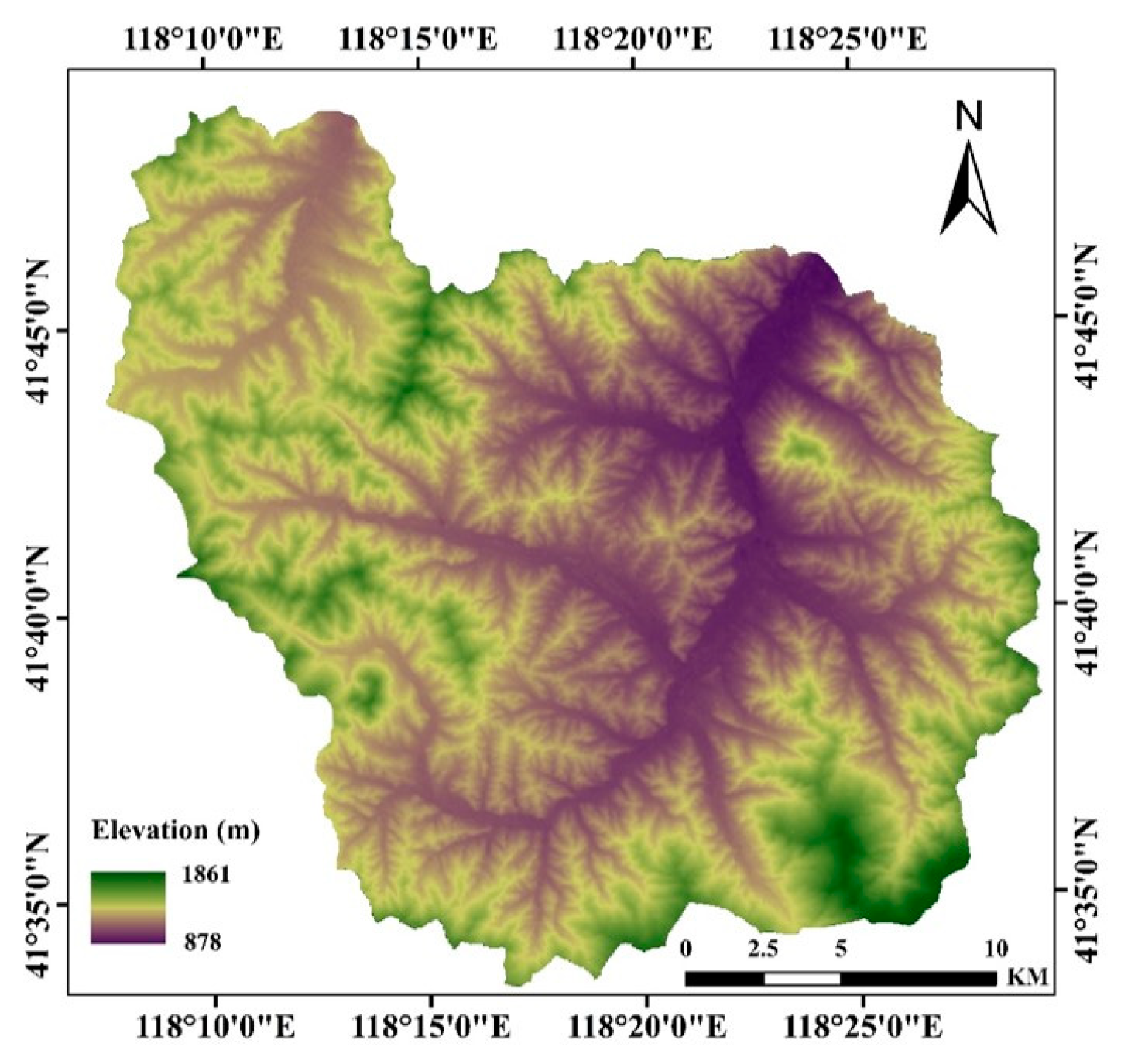

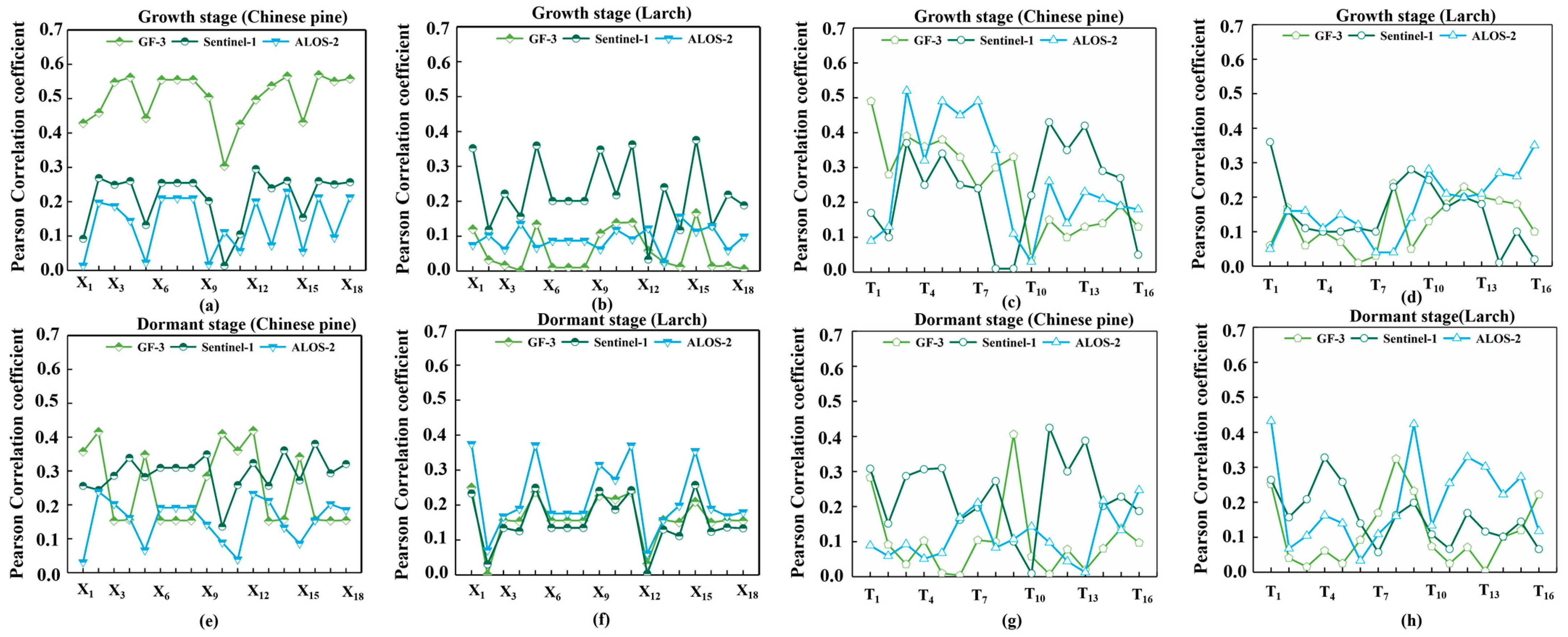

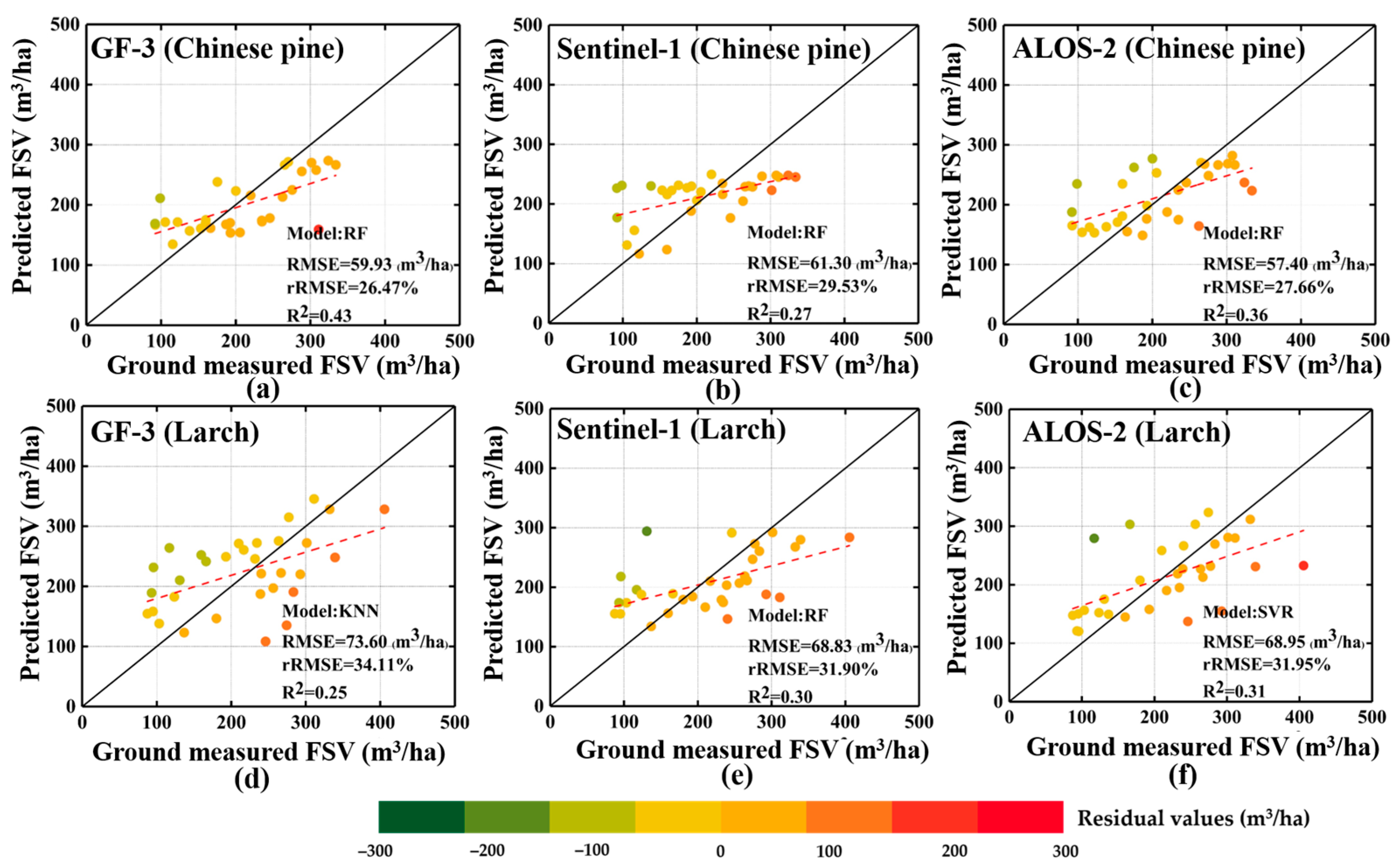
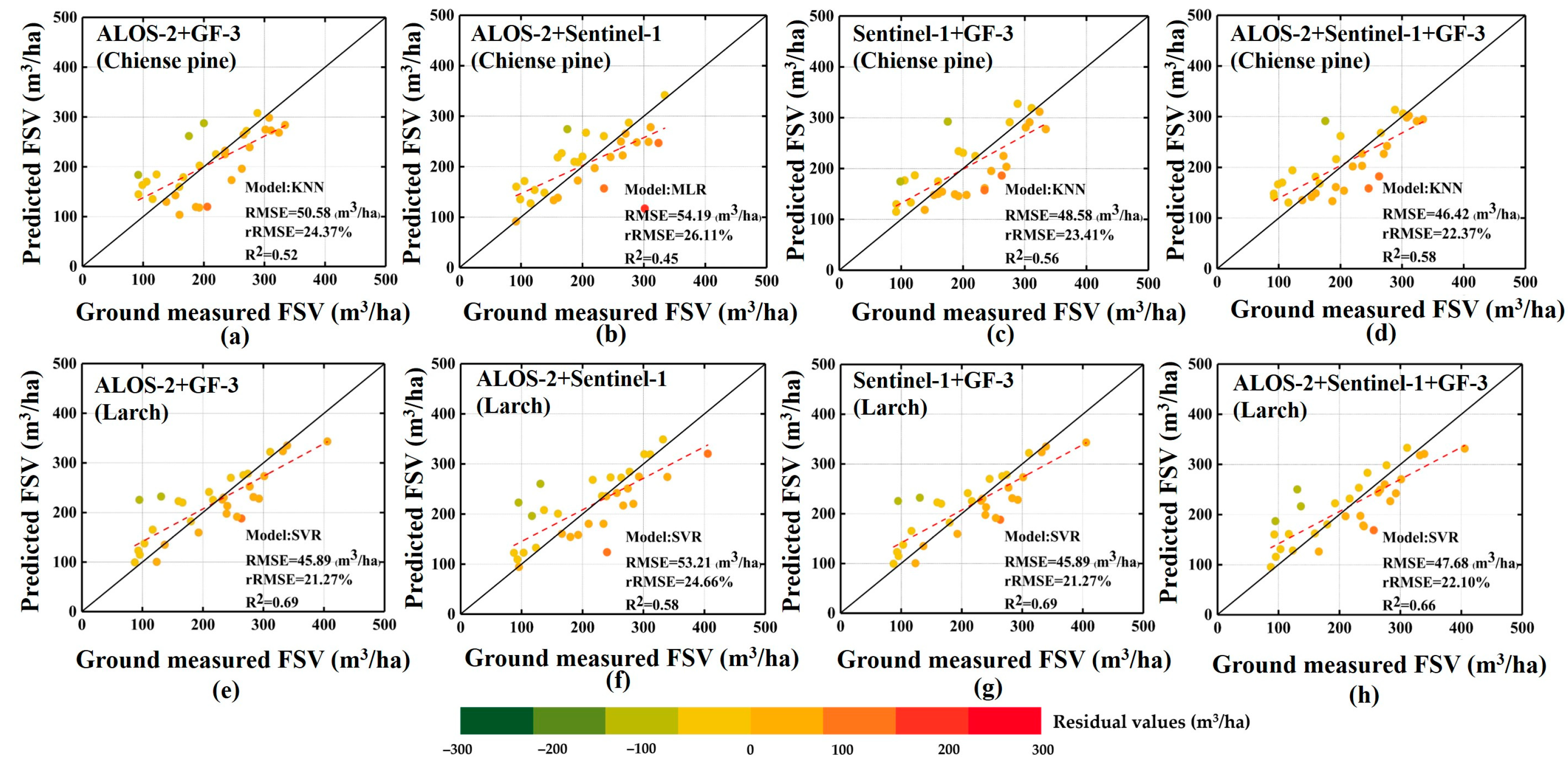
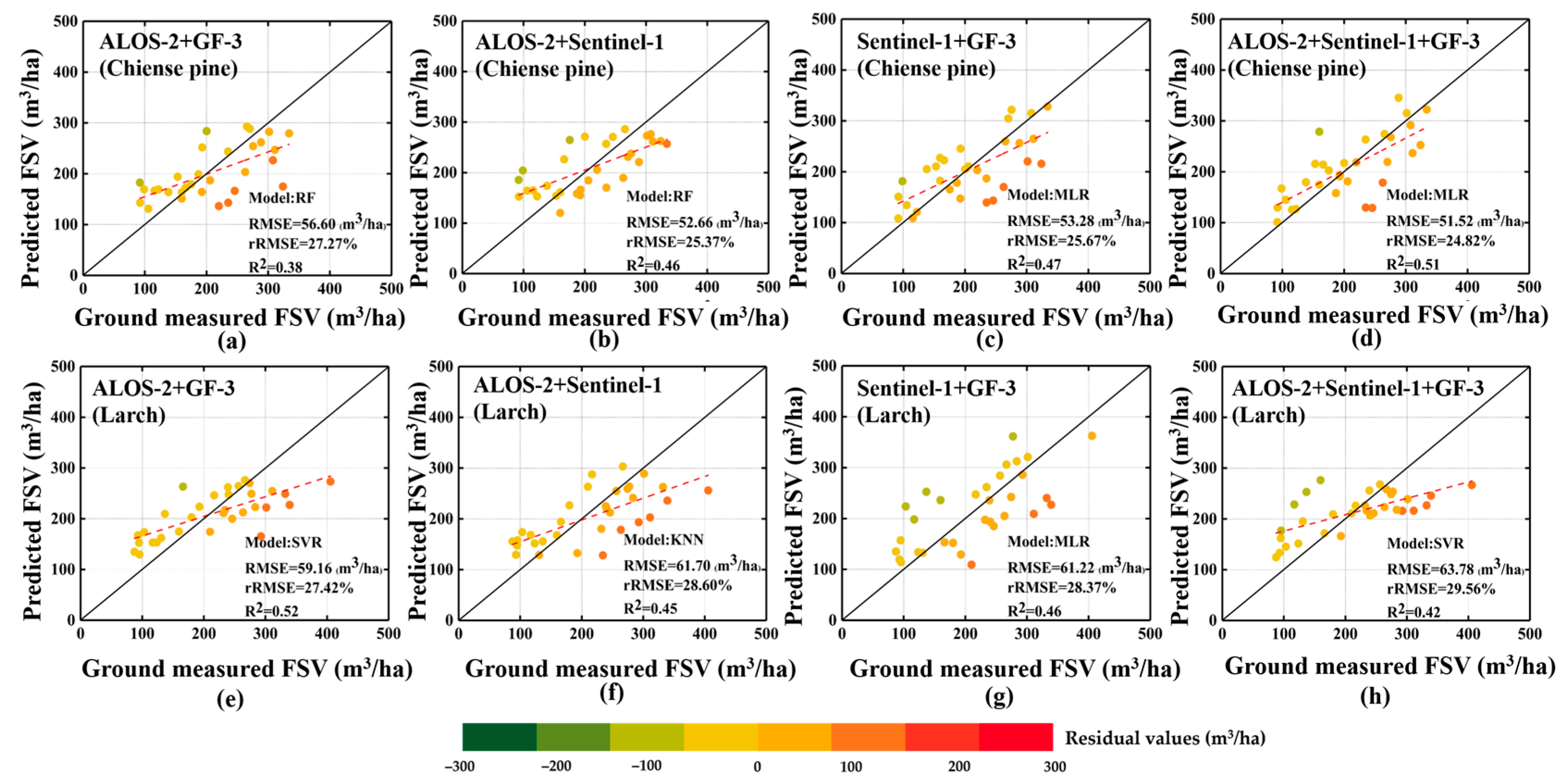
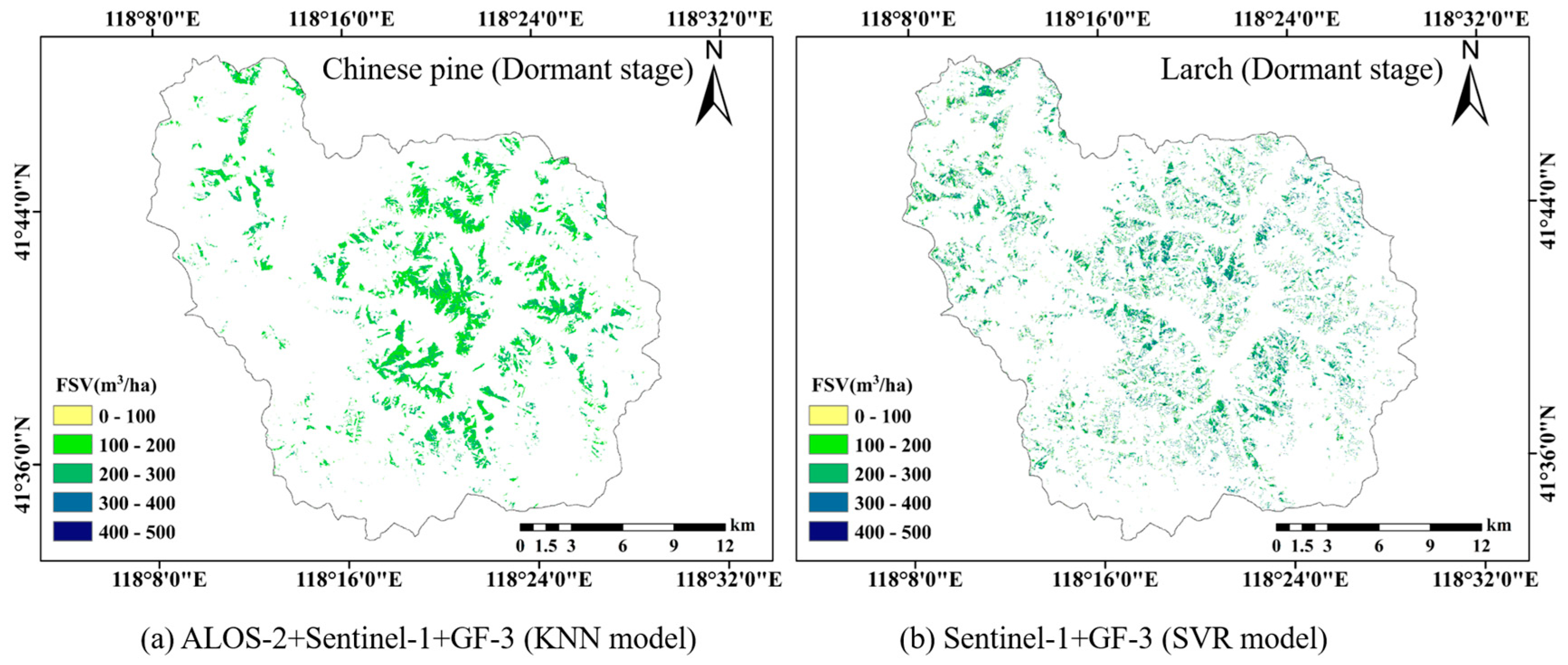

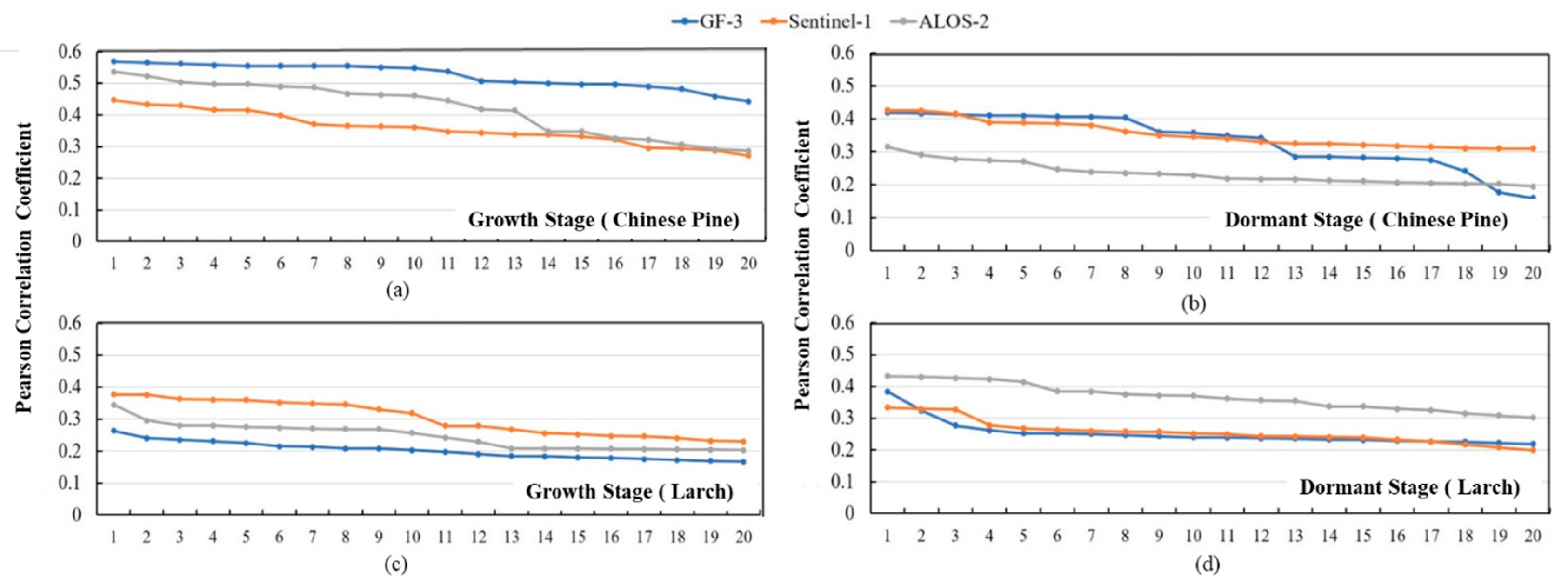
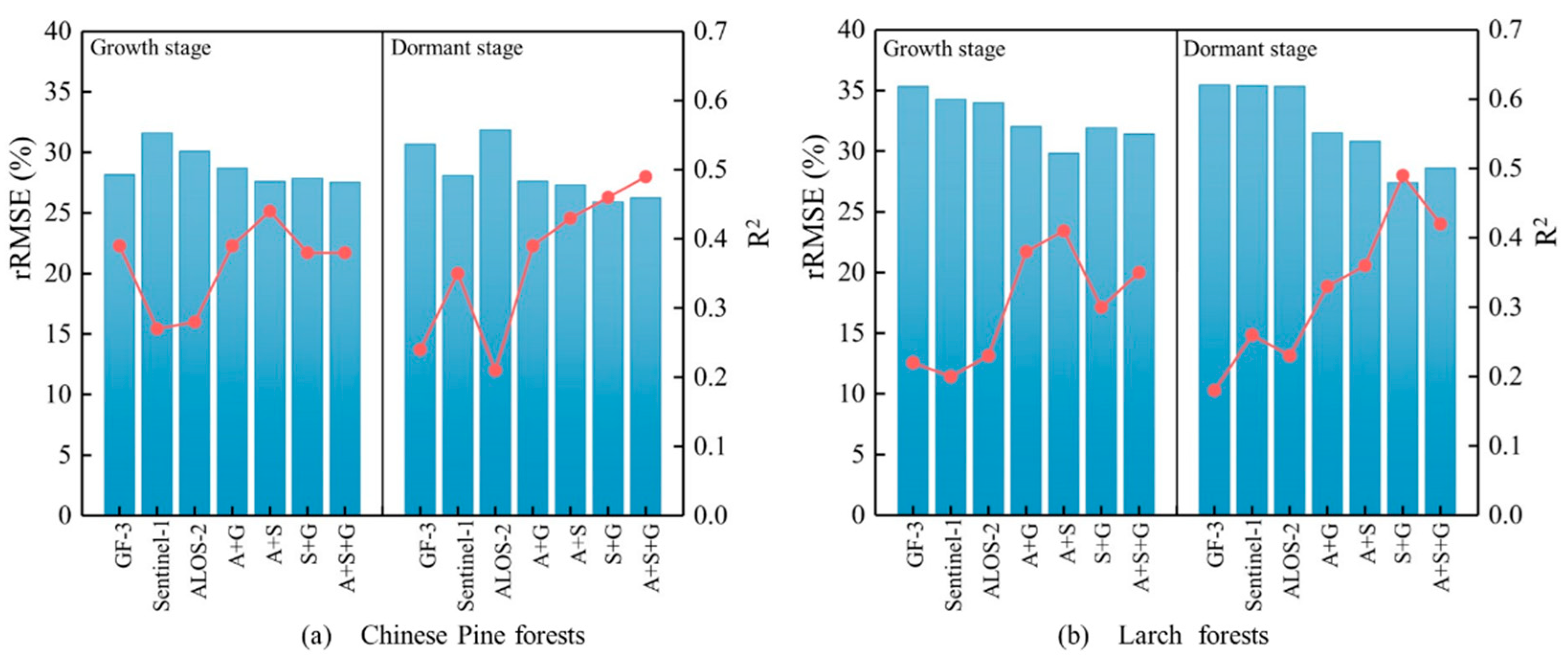
| Growth Phases | Band | Satellites | Acquired Date | Polarization Modes | Incidence Angle | Spatial Resolutions |
|---|---|---|---|---|---|---|
| Dormant stage | C | GF-3 | 18 March 2017 | HH/HV | 38.57° | 2.25 m × 3.12 m |
| C | Sentinel-1 | 4 March 2017 | VV/VH | 39.50° | 2.32 m × 13.89 m | |
| L | ALOS-2 | 9 March 2017 | HH/HV | 31.41° | 4.29 m × 3.09 m | |
| Growth stage | C | GF-3 | 5 August 2017 | HH/HV | 29.65° | 2.25 m × 5.31 m |
| C | Sentinel-1 | 14 August 2017 | VV/VH | 39.49° | 2.32 m × 13.89 m | |
| L | ALOS-2 | 26 August 2017 | HH/HV | 31.60° | 4.29 m × 3.09 m |
| Number | Data Sources | SAR Images | Variable Sets |
|---|---|---|---|
| 1 | Single band | GF-3 (G) | Backscattering coefficients, their derived variables, decomposition variables, RVI, and texture variables |
| 2 | Sentinel-1(S) | ||
| 3 | ALOS-2(A) | ||
| 4 | Multi-band | A + G | Variables obtained from multi-band SAR images |
| 5 | A + S | ||
| 6 | S + G | ||
| 7 | A + G + S |
| SAR Images | Models | Chinese Pine | Larch | ||||
|---|---|---|---|---|---|---|---|
| RMSE (m3/ha) | rRMSE (%) | R2 | RMSE (m3/ha) | rRMSE (%) | R2 | ||
| GF-3 | MLR | 71.15 | 34.28 | 0.10 | 79.62 | 36.90 | 0.10 |
| KNN | 64.88 | 31.26 | 0.20 | 77.44 | 35.89 | 0.17 | |
| SVR | 58.90 | 28.38 | 0.34 | 78.96 | 36.60 | 0.16 | |
| RF | 59.89 | 28.85 | 0.31 | 69.80 | 32.35 | 0.28 | |
| Sentinel-1 | MLR | 67.34 | 32.45 | 0.14 | 88.01 | 40.79 | 0.36 |
| KNN | 49.79 | 23.99 | 0.53 | 77.83 | 36.07 | 0.14 | |
| SVR | 57.81 | 27.85 | 0.37 | 69.37 | 32.15 | 0.29 | |
| RF | 58.18 | 28.03 | 0.34 | 70.20 | 32.54 | 0.26 | |
| ALOS-2 | MLR | 73.14 | 35.24 | 0.10 | 74.13 | 34.36 | 0.26 |
| KNN | 65.45 | 31.54 | 0.26 | 75.55 | 35.01 | 0.16 | |
| SVR | 64.09 | 30.88 | 0.20 | 86.24 | 39.97 | 0.18 | |
| RF | 61.61 | 29.69 | 0.27 | 68.95 | 31.96 | 0.32 | |
| SAR Images | Models | Chinese Pine | Larch | ||||
|---|---|---|---|---|---|---|---|
| RMSE (m3/ha) | rRMSE (%) | R2 | RMSE (m3/ha) | rRMSE (%) | R2 | ||
| GF-3 | MLR | 61.45 | 29.61 | 0.39 | 76.62 | 35.51 | 0.38 |
| KNN | 62.01 | 29.88 | 0.32 | 73.60 | 34.11 | 0.25 | |
| SVR | 55.26 | 26.62 | 0.42 | 76.27 | 35.35 | 0.14 | |
| RF | 59.93 | 26.47 | 0.43 | 77.59 | 35.96 | 0.10 | |
| Sentinel-1 | MLR | 70.67 | 34.05 | 0.29 | 78.54 | 36.40 | 0.10 |
| KNN | 63.50 | 30.59 | 0.26 | 74.55 | 34.55 | 0.18 | |
| SVR | 66.82 | 32.20 | 0.24 | 73.96 | 34.28 | 0.22 | |
| RF | 61.30 | 29.53 | 0.27 | 68.83 | 31.90 | 0.30 | |
| ALOS-2 | MLR | 64.01 | 30.84 | 0.24 | 77.02 | 35.70 | 0.18 |
| KNN | 66.47 | 32.03 | 0.17 | 74.21 | 34.40 | 0.21 | |
| SVR | 61.85 | 29.80 | 0.34 | 68.95 | 31.95 | 0.31 | |
| RF | 57.40 | 27.66 | 0.36 | 73.09 | 33.88 | 0.23 | |
| SAR Images | Models | Chinese Pine | Larch | ||||
|---|---|---|---|---|---|---|---|
| RMSE (m3/ha) | rRMSE (%) | R2 | RMSE (m3/ha) | rRMSE (%) | R2 | ||
| A + G | MLR | 57.51 | 27.71 | 0.42 | 74.18 | 34.38 | 0.29 |
| KNN | 50.58 | 24.37 | 0.52 | 66.29 | 30.72 | 0.35 | |
| SVR | 60.28 | 29.04 | 0.30 | 59.08 | 27.38 | 0.48 | |
| RF | 61.01 | 29.40 | 0.33 | 72.44 | 33.57 | 0.21 | |
| A + S | MLR | 54.19 | 26.11 | 0.45 | 74.13 | 34.36 | 0.26 |
| KNN | 54.75 | 26.38 | 0.44 | 69.03 | 31.99 | 0.29 | |
| SVR | 60.45 | 29.13 | 0.41 | 53.21 | 24.66 | 0.58 | |
| RF | 57.44 | 27.67 | 0.42 | 69.72 | 32.32 | 0.31 | |
| S + G | MLR | 54.75 | 26.38 | 0.47 | 59.54 | 27.60 | 0.53 |
| KNN | 48.58 | 23.41 | 0.56 | 61.77 | 28.63 | 0.46 | |
| SVR | 58.23 | 28.04 | 0.34 | 45.89 | 21.27 | 0.69 | |
| RF | 53.59 | 25.82 | 0.45 | 69.30 | 32.12 | 0.29 | |
| A + S + G | MLR | 52.58 | 25.33 | 0.61 | 70.11 | 32.49 | 0.29 |
| KNN | 46.42 | 22.37 | 0.58 | 58.29 | 27.02 | 0.49 | |
| SVR | 59.74 | 28.78 | 0.41 | 47.68 | 22.10 | 0.66 | |
| RF | 59.00 | 28.42 | 0.35 | 70.76 | 32.80 | 0.25 | |
| SAR Images | Models | Chinese Pine | Larch | ||||
|---|---|---|---|---|---|---|---|
| RMSE (m3/ha) | rRMSE (%) | R2 | RMSE (m3/ha) | rRMSE (%) | R2 | ||
| A + G | MLR | 58.99 | 28.42 | 0.53 | 73.14 | 33.90 | 0.53 |
| KNN | 59.72 | 28.77 | 0.35 | 71.15 | 32.98 | 0.27 | |
| SVR | 62.88 | 30.30 | 0.31 | 59.16 | 27.42 | 0.52 | |
| RF | 56.60 | 27.27 | 0.38 | 72.79 | 33.74 | 0.21 | |
| A + S | MLR | 57.51 | 27.71 | 0.57 | 63.09 | 29.24 | 0.47 |
| KNN | 57.88 | 27.89 | 0.39 | 61.70 | 28.60 | 0.45 | |
| SVR | 61.06 | 29.42 | 0.32 | 65.81 | 30.50 | 0.36 | |
| RF | 52.66 | 25.37 | 0.46 | 66.69 | 30.90 | 0.35 | |
| S + G | MLR | 53.28 | 25.67 | 0.47 | 61.22 | 28.37 | 0.46 |
| KNN | 60.64 | 29.22 | 0.36 | 77.74 | 36.03 | 0.12 | |
| SVR | 60.72 | 29.25 | 0.28 | 67.20 | 31.14 | 0.34 | |
| RF | 56.67 | 27.30 | 0.40 | 69.26 | 32.10 | 0.28 | |
| A + S + G | MLR | 51.52 | 24.82 | 0.51 | 65.28 | 30.26 | 0.46 |
| KNN | 58.93 | 28.40 | 0.34 | 77.26 | 35.81 | 0.13 | |
| SVR | 59.71 | 28.77 | 0.32 | 63.78 | 29.56 | 0.42 | |
| RF | 58.56 | 28.21 | 0.35 | 64.67 | 29.97 | 0.38 | |
Disclaimer/Publisher’s Note: The statements, opinions and data contained in all publications are solely those of the individual author(s) and contributor(s) and not of MDPI and/or the editor(s). MDPI and/or the editor(s) disclaim responsibility for any injury to people or property resulting from any ideas, methods, instructions or products referred to in the content. |
© 2024 by the authors. Licensee MDPI, Basel, Switzerland. This article is an open access article distributed under the terms and conditions of the Creative Commons Attribution (CC BY) license (https://creativecommons.org/licenses/by/4.0/).
Share and Cite
Long, J.; Zheng, H.; Ye, Z.; Zhang, T.; Li, X. The Impacts of Phenological Stages within the Annual Cycle on Mapping Forest Stock Volume Using Multi-Band Dual-Polarization SAR Images in Boreal Forests. Forests 2024, 15, 1660. https://doi.org/10.3390/f15091660
Long J, Zheng H, Ye Z, Zhang T, Li X. The Impacts of Phenological Stages within the Annual Cycle on Mapping Forest Stock Volume Using Multi-Band Dual-Polarization SAR Images in Boreal Forests. Forests. 2024; 15(9):1660. https://doi.org/10.3390/f15091660
Chicago/Turabian StyleLong, Jiangping, Huanna Zheng, Zilin Ye, Tingchen Zhang, and Xunwei Li. 2024. "The Impacts of Phenological Stages within the Annual Cycle on Mapping Forest Stock Volume Using Multi-Band Dual-Polarization SAR Images in Boreal Forests" Forests 15, no. 9: 1660. https://doi.org/10.3390/f15091660






